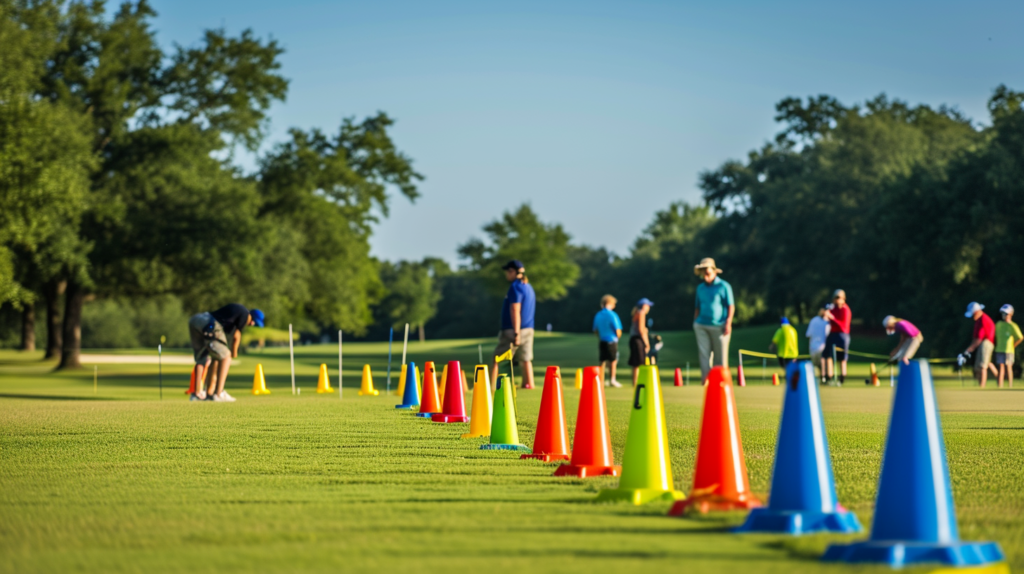Have you ever wondered what that strange term “shotgun start” refers to when talked about for golf tournaments?
A shotgun start is a popular way to commence recreational golf events, member club tournaments or charity fundraisers where players all start holes simultaneously to accommodate more entrants and speed of pace.
Let’s dive in to understand exactly why and how shotgun start works as an alternative tournament starting format.
What is a Shotgun Start?

A shotgun start is a format for beginning a golf tournament where all players or groups of players start at the same time from different holes across the golf course.
Instead of having consecutive tee times where groups start on the first hole, one after each other, a shotgun start has all participating players start simultaneously from varied locations on the course layout.
The start is signaled by an actual shotgun blast or loud horn which alerts players to begin play at their assigned holes. The term “shotgun start” comes from how the start resembles a shotgun firing scattered pellets in all different directions at once.
This start format allows large fields to be accommodated by spreading players out immediately rather than needing to schedule dozens or hundreds of sequential tee times.
It also helps improve the pace of play with less chance for backups and slower groups holding others up across 18 holes. With all players beginning at once, there is increased fairness as no one gains an advantage or faces more difficult conditions on the course.
Popular mainly with one-day club tournaments or member events, the shotgun start requires more planning and coordination but leads to an exciting, efficient start for recreational competitions.
Reasons for Using a Shotgun Start

There are several advantages and situations where utilizing a shotgun start works well for golf tournaments and events:
Accommodate Large Player Fields
The shotgun start shines when larger tournaments need to have space for potentially hundreds of entrants to all play in the event simultaneously.
Most public or private golf courses do not have the capacity in a regular day to handle 120, 140 or 160+ golfers teeing off at standard intervals.
Trying to accommodate a full field in a member tournament, corporate golf outing or charity fundraiser would result in extremely early and late tee times plus very slow rounds dragging on for hours.
The shotgun start allows everyone to head out at once with groups evenly dispersed among all holes on the front nine, back nine and possibly even extra par 3 holes if available. This immediately gets the entire field moving without scheduling challenges.
It also keeps the event contained within the preferred morning or afternoon timeframe. With more courses limited on total holes and tee boxes, packing players in via a shotgun start enables events to accept maximum registrants and participation.
Improve Pace of Play
With players scattered across the course at different starting points, bottlenecks and slowdowns due to backed up groups are significantly reduced versus consecutive tee times.
Players move at their own pace within their foursome with ideally little to no waiting on other golfers ahead. This enables an acceptable pace of play to be established and maintained as players make their way in order back to the clubhouse.
Cumulative delays that would normally add up from groups stacking up are avoided. Tournaments are able to meet target round times and conclude efficiently.
The steady play also means stronger golfers are less frustrated by playing speed and slower players or high handicappers feel less pressure trying to keep up. Fair, reasonable pace expectations lead to an enjoyable experience.
Marshals can assist any groups falling well behind the intended pace without outside slow groups being an issue.
Provide Equal Course Conditions
In tournaments with a morning and afternoon wave of tee times, later groups are often at a disadvantage if course conditions deteriorate in the afternoons as temperatures rise, wind picks up or greens get bumpier.
With everyone beginning play concurrently in a shotgun, initial course conditions are generally equalized so tee and green times do not impact someone’s likelihood of success. No group should gain an edge based on more favorable conditions or easier initial hole locations.
Weather factors will still come into play as the round progresses but at least everyone starts on level footing condition-wise.
If weather delays were needed before resuming a shotgun start tournament, play also picks up where it left off with continuity for remaining holes and consistent conditions retained as much as possible.
Consecutive tee time waves that get interrupted then have to restart based on gaps and uneven delays group to group across holes and nines.
The Shotgun Start Process

The organization and communication required to pull off a well-run shotgun start means extra work is needed compared to standard tee times but the process enables fantastic, simultaneous starts. Key steps include:
Assign Starting Holes in a Balanced, Clustered Manner
The course’s tournament director and staff must strategically assign groupings of four players to each starting hole working outward from the first tee area while also populating front, middle and back holes too.
Effort is made to balance out the strength and playing levels of groups across the dispersed mix with stronger teams usually split up to begin play spread out. This distributes what are expected to be quicker playing groups evenly so fewer slowdowns occur.
Starting hole assignments also avoid unusual criss-crossing routes.
Prepare Distinguished Hole Markers
To direct dozens of starting foursomes easily, numbered signs, standing fold signs or colored balloons are set out early to mark each starting hole’s tee box whether it be a par four, par five or par three hole start.
This also reminds players heading to their first hole to not forget this tournament has scattered starts at each marker across the property. Staff, volunteers or signage also guide participants driving in the parking lot.
Make Announcements Leading Up to the Shotgun
As players arrive, register and prepare alongside their cart or bag, periodic announcements remind all participants to make their way to their assigned starting holes with ample time to be ready to play.
A counting down time warning like you would hear in arace builds extra anticipation and urgency to get moving into position with a minute or so to spare.
Sound the Shotgun Blast to Commence Play
Right at the published event start gun time (e.g. 8:00 AM), organizers trigger the shotgun blast sound effect or loud electric air siren/horn to conclusively signal tournament play has begun.
This start blare can happen right at the clubhouse and/or be projected via speakers set out by certain greens or holes to extend the range every group can clearly hear the launch.
Some events even fire off actual shotguns loaded with blanks to really emphasize the simultaneous start.
Progress Around Back to Clubhouse
Scorecards have players finishing wherever their shotgun start hole lies then continuing sequentially around the remaining holes to route back to the clubhouse and scoring area upon completion.
No assigned group should ever need to cross over or intersect with starting holes or other groups if distribution is balanced properly. This avoids awkward leaps to holes out of order.
Front nine starters work back in while back nine starters come forward to meet in the middle before closing out.
Marshals Help Facilitate Flow
More marshalls are utilized during shotgun events to spot check pace and flow across the various starting holes then roving to assist any backed up clusters.
Having an expanded team of hole captains or marshals ensures groups do not fall excessively behind the others risking crossover confusion.
These pace runners also serve to administer rulings, find lost balls and handle any other decisions when required as players make their way around the outward or inward half.
Considerations for Hosting a Shotgun Start

In determining if a shotgun start fits a club’s next member tournament needs or for greeting incoming larger golf outings, weighing several key factors helps assess viability:
Number of Players Accommodated
Though dependent on overall course length, par and availability of extra tee boxes, a typical private club layout can only handle between 120 to 144 players in a shotgun.
This maximum stems from physical spacing limits before groups would stack up too closely or routing flow would get disrupted going hole to hole. If an event has more than 150 golfers expected, even the shotgun format may be unfeasible requiring multiple waves instead.
Suitability for Single vs Multiple Rounds
Due to the inherent nature of then requiring time to catch up and finalize scores before making additional hole assignments, traditional shotguns function best for one-day or single round tournaments.
For a 36 or 54-hole competition, it becomes immensely complicated to halt play then reorganize new starting spots twice more to avoid conflicts. This makes standard tee times preferable for multi-round championships.
Staffing and Setup Logistics
To start dozens of golfer groupings simultaneously, extra volunteers or staff must arrive far earlier to begin placing hole and cart signs then shuttling players as start time approaches.
During play, more personnel is needed walking as marshals to oversee flow and rulings too versus scattered tee times. This staffing demand and setup workload must be prepared for to ensure organized execution not sacrificing quality of event.
Conclusion
In conclusion, a shotgun start serves as an efficient, fair and exhilarating format for kicking off golf tournaments and events, especially when managing large fields.
By dispersing participant groupings simultaneously across all holes with a loud siren blast, backed up play is avoided, pace improves, and no advantage is gained over conditions. It does demand more resources and coordination but creates a scattered yet organized start.
For tournament directors seeking to maximize fun and participants, implementing the shotgun start process ensures a fantastic experience.



